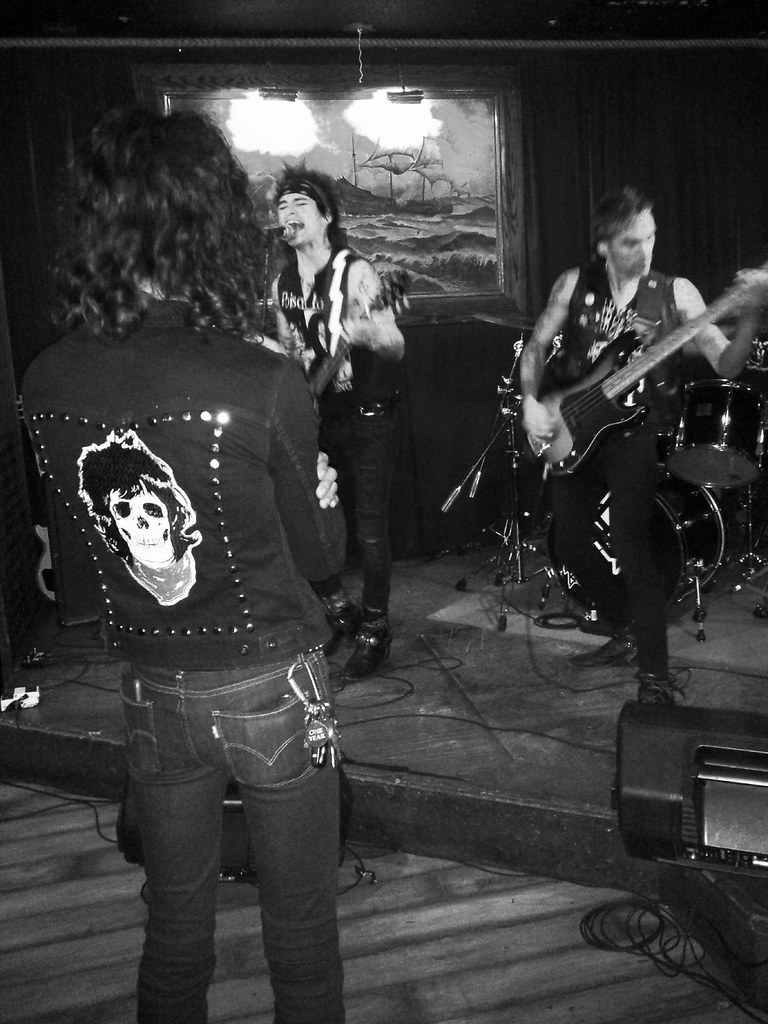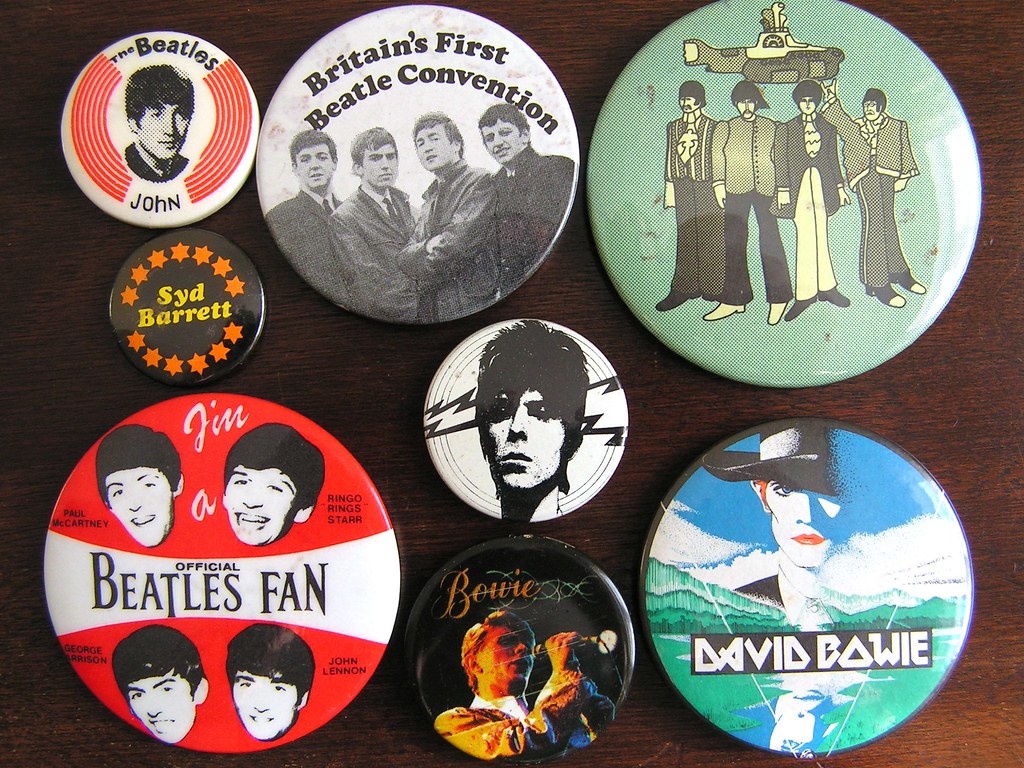Rock and Roll, dubbed ‘The Devil’s Music‘, was a revolutionary genre that sent shockwaves through the American music landscape in the 1950s. Born from a diverse and rich blend of musical roots such as blues, swing, and jazz, this style was infused with the life force of African American culture. As much as its rhythms were captivating, its emergence was fraught with controversy stemming from societal, racial, and socio-economic tensions.
Cover photo credit “Rock music badges 5” by jovike is licensed under CC BY-NC 2.0
Table of Contents
The new wave of tantalizing beats and provocative performances was quickly marked as a source of moral decay by conservative factions, setting the stage for a paradigm shift in American society. In our discourse, we will venture into the era that birthed rock and roll, the societal influences that shaped its reception, and how this powerful musical phenomenon became an emblematic expression of youth rebellion.
Societal Context and Emergence of Rock and Roll
The Roots of Rock and Roll
Rock and roll emerged from an intermingling of African American musical traditions, particularly the blues, jazz, and swing. These genres, characterized by their improvisational techniques, complex rhythms and emotional depth, played a significant role in the development of rock and roll. It was the convergence and evolution of these styles, amplified by the artistic experimentation of African American musicians, which eventually gave birth to the new music genre.
Racial and Socio-economic Factors
These genre-blending musicians often hailed from impoverished backgrounds and battled systemic racial prejudice. The struggle and compromising social conditions of their lives deeply influenced rock’s rebellious tone and confrontational lyrics- a primary reason the music was labeled as dangerous. The societal climate of racism and fear of cultural integration were reflected in the public’s initial reception of this new genre, amplifying its image as ‘The Devil’s Music.’
The Birth of a Rebellion
The emergence of rock and roll in mainstream American culture during the post-war era of the 1950s was a cultural shockwave. The traditional sensibilities of an older generation were wholly unprepared for this audacious form of musical expression. The lyrics, brimming over with the raw realities of a segregated society and the struggles of the youth, defied societal norms and expectations. This defiance lent a rebellious tone to rock, making it even more appealing to youth craving freedom from societal constraints.
The Fear of Change
The controversy of rock and roll was further heightened by the significant role it played in the desegregation of music. This music genre disregarded racial lines, popularizing African American cultural expression in white American households. Rock’s influence on desegregation incited fear in conservative sectors of the population, leading to further scapegoating of the genre. Its association with the breaking of societal barriers hugged closely to the questions on morality and constituted an additional reason for its controversial branding as ‘The Devil’s Music.’
The Intrigue of Rock and Roll
Rock and roll music, with its raw, edgy style bursting with unfiltered social critique, was perceived by many as a direct challenge to established societal norms. In particular, certain conservative religious groups found its implicit endorsement of sex, drugs, and rebellion against traditional authority disconcerting. This led to orchestrated campaigns against rock and roll, branding it ‘The Devil’s Music.’ The notion of rock and roll as immoral, hazardous, and anti-establishment ironically fueled its popularity among liberal-minded youths, ultimately morphing it into a cultural juggernaut spanning generations.

Rock and Roll Attributed to Moral Decay
The Onset of Moral Panic
Witnessing the ascent of rock and roll music in the era of the 1950s, conservative sections of America were deeply unsettled. This innovative and vibrant genre was not just a different kind of music, it posed an existential threat to mainstream societal values, sparking widespread moral panic. The most vociferous critics were often those hailing from religious quarters, who firmly held the view that rock and roll marked the advent of moral degradation.
Rock and roll music was often synonymous with teenage rebellion, a linkage that sent shudders down the spines of conventional adults. As flag bearers of this rebellion, iconic performers like Elvis Presley and Jerry Lee Lewis shattered traditional norms, leaving parents concerned about the impact of such uninhibited exposure on their children. Undoubtedly, the shifting social attitudes among teenagers – noticeable in escalating rates of promiscuity and perceived unruliness – added fuel to these fears.
Rock and Roll as ‘The Devil’s Music’
The label ‘The Devil’s Music’ surfaced as religious and conservative critics pounced on the often provoking song lyrics, explicit dance moves, and the taboo-breaking origins of rock and roll. This originated from African American secular music forms like the blues, which already had its share of spiritual controversy. By fusing elements from rhythm and blues and country music, rock and roll emerged as a rejuvenated, amplified defiance of conventional music norms.
Adding fuel to the fire was the shift in popular culture ushered in by TV programs like “American Bandstand,” where youths gyrated to the new sounds of rock and roll, scandalizing conservative viewers. It was a spectacle that prompted spiritual leaders to condemn rock and roll in sermons, associating it with sin, wild living, and immorality.
Jittery Authorities Combat Rock and Roll
To stem the perceived tide of moral decay, authorities took various measures. There was an effort to censor and suppress the spread of rock and roll through bans in several cities and the prohibition of concerts in certain venues. Additionally, some radio stations refused to play rock and roll music while artists faced boycotts, and DJs faced job termination threats for promoting this genre.
The Power of Controversy
Despite the negative image, the criticism of rock and roll served to increase its appeal. As the music continued to evolve and penetrate mainstream culture, it became clear that rock and roll was more than just a fad. It was an unstoppable force, resonating with younger generations and forever changing the landscape of American music.
Thus, the tag ‘The Devil’s Music’ wielded by conservative shades of society actually fueled the notorious fame of rock and roll. By associating it with rebellion, it became a powerful channel for young people to express themselves. The attempt to suppress it only added to its glamour, making it the embodiment of freedom and rebellion.
Unleashing the ‘Demon’ in Rock and Roll Music
In the post-WWII era, tensions arose as rock and roll music emerged to challenge societal norms and accelerate profound cultural changes. This new genre, with its iconoclastic spirit, sent shockwaves through the status quo, triggering a significant generational divide. Primarily, it was the older generation’s resistance that solidified rock and roll’s reputation as subversive and disruptive, even categorizing it as ‘The Devil’s Music’.
Key Musicians Accused
Elvis Presley: The Aptly Named ‘King of Rock and Roll’
Elvis Presley, hailed as the King of Rock and Roll, was a key catalyst in shaping and popularizing this controversial genre. His innovative mix of blues, gospel, and country music veered off the beaten path, captivating audiences with its novelty and allure. Elvis was equally renowned for his risqué stage performances marked by infamous hip movements, which conservative circles dubbed as indecent. The prevailing Christian-focused older generation viewed both his music and on-stage antics as corrupt influences on the youth. Consequently, the overt sensuality in his acts lent further weight to the label of ‘The Devil’s Music’.
Chuck Berry and the Birth of Rock and Roll
Chuck Berry, another pioneer of rock and roll, is often credited with defining the rhythm and blues sound that later evolved into rock and roll. Berry’s music was fast-paced and laden with lyrics that reflected the rebellious phase of teenagehood. Coupled with his showmanship skills, Berry’s performances were enchanting and hypnotic. The older populace, however, was not amused. They believed Berry’s music was too raunchy, wild, and unrefined, effectively making it evil. He was labeled a promoter of moral decay and debauchery, pushing rock and roll further into ‘The Devil’s Music’ territory.
Little Richard and the Bold Onstage Persona
Little Richard was another key figure accused of promoting devilish music. His dynamic stage performances included flamboyant costume designs, wild piano playing, and an unreserved theatrical presence. His music emphasized themes of freedom, rebellion, and individuality, which appealed to the younger generation but ruffled the feathers of the conservative older adults. The boldness and audacity in Little Richard’s music, merged with his uninhibited persona, were seen as avenues for cultivating immorality and decadence among the youth. This earned him, along with his rock and roll contemporaries, accusations of playing ‘The Devil’s Music’.
Public Perception and the Label ‘Devil’s Music’
The emergence of rock and roll as a revolutionary sound faced an array of public perceptions. It struck a chord with the younger generation, who praised these musicians for their unparalleled authenticity and audacity. The lyrics echoed their rebellious spirit and resonated with their quest for liberation, making them champions of this disruptive music culture. Contrarily, the older generations steeped in traditional and religious beliefs, took offense. They voiced their concern over the unconventional ways of the musicians crediting them for the deviation of the youth from societal norms, endorsing sinful activities, and thus equating the rise of rock and roll to an elevation in immorality. This led to rock and roll being notoriously labeled ‘The Devil’s Music’.

Photo by timothyeberly on Unsplash
Rock and Roll: The Reverberating Roar of Rebellion
The mid-twentieth century bore witness to the rise of rock and roll—a consequent rebellion epitomized by its blistering emotions, rhythmic eruptions, and tempestuous soundscapes. Visionary artists like Chuck Berry, Little Richard, and Elvis Presley were the torchbearers of the genre, creating a profound impact on the younger generation, who found their voices and their identity magnified in the unbridled fervor of this music.
The roots of rock and roll are a rich fusion of African American genres such as rhythm and blues, and gospel, enmeshed with elements of country and western music. Every beat, every strum, and every lyric was a scream of revolt against age-old societal norms, a plea for individuality, and the freedom to question and challenge the status quo. The booming notes that emanated from the roaring speakers sparked an audacious spirit of rebellion, reassuring a generation yearning to expand their boundaries that it was okay to defy, okay to question, okay to rebel.
The Music of the Devil
But why was it dubbed ‘The Devil’s Music’? The label comes primarily from conservative minds, who were appalled by the perceived sexual nature and defiant attitude of rock and roll. The music’s pulsing beat, overtly emotional lyrics, and suggestive performances were seen as provocative and immoral. Moreover, the mingling of black and white cultures inherent in its creation flew directly in the face of racial segregation that still shadowed much of America at the time.
“Devil’s music” became a term used by religious and conservative societies to condemn rock and roll for its supposed corrupting influence on youth. The loud, raucous music seemed disruptive, threatening to established norms, and ladder-shaking. Its perceived sinfulness was twofold — cultural rebellion against the older generation, and racial and social integration that was seen as a threat by some groups.
Rebellion and Self-expression: The Heart of Rock ‘n’ Roll
The act of rebellion was part and parcel of rock and roll’s allure to the young. The electrifying energy, the freedom of expressions, and even the scandalousness of it all tantalized the youth, providing an outlet for their dissatisfaction with the societal constraints they felt. Artists like Elvis Presley, for instance, embodied this freedom, gyrating his hips in performances to the shock and horror of conservative older audiences and the delight of the youth.
Rock and roll also gave rise to increased autonomy for youth. With the coming of age narratives often explored in the lyrics, and the performers often being young themselves, rock and roll reflected the experiences and emotions of their listeners. It didn’t just speak for a generation, but it also taught the generation how to speak, how to express themselves, and how to fight for their rights.
Rock and roll, at its heart, stands as a potent emblem of rejuvenation, liberation, and rebellion for young people everywhere. Despite being dubbed ‘The Devil’s Music,’ or perhaps even because of this moniker, this genre significantly influenced the journey of the younger generation amid a period of severe societal and cultural shifts in the 1950s and 60s. Today, it still holds its place as an indelible piece of music history, offering a captivating blend of sound and emotion that continues to be as rebellious and beguiling as ever.

Modern Perceptions and Evolution of the ‘Devil’s Music’
Refashioning the Perception of ‘The Devil’s Music’
In the unfolding of the 20th and 21st century, rock and roll, initially denounced as ‘The Devil’s Music,’ has weathered dramatic shifts in public perception. Born of the rebellious spirit that defined 1950s America, rock music represented a significant divergence from the accepted norms and mores of the era, thus inviting widespread societal disapproval. However, this initial perception has since been recast and continues to feed into the genre’s evolution, fragmenting it into a spectrum of sub-genres, each equipped with its unique flavor and aura.
Rock’s Notorious Reputation and the Rise of New Genres
In the mid-20th century, the racy lyrics and free-spirited performances of rock and roll were seen as a moral threat by conservative America. Adults of that era, reared on a strict diet of swing, jazz, and gospel, were alarmed by the adverse influence they believed rock music had on the youth. This gave rise to rock’s notorious reputation and its colloquial reference—’the devil’s music’. The infusion of rebellious lyricism, amplified instruments, and aggressive drumming offered a stark contrast to previous, more harmonious forms of music.
Over the next few decades, however, this reputation didn’t hinder rock’s progression. On the contrary, it fueled the emergence of high-octane genres such as punk rock and heavy metal. Both genres further pushed the boundaries set by original rock music, not only through innovative composition but also through darker and even more controversial themes.
Heavy Metal and Punk: Embracing the ‘Devilish’ Stigma
Heavy metal, with its dark themes and cacophonous sounds, took rock’s ‘devilish’ stigma and fully embraced it. Bands like ‘Black Sabbath’ and ‘Judas Priest’ did not shy away from using dark and occult-themed imagery in their lyrics and stage shows. This has led many to associate heavy metal with outright Satanism, even if that is rarely the musicians’ intent.
Similarly, Punk rock, emerging in the 1970s, rejected mainstream norms and embraced anarchy. The loud, aggressive music and DIY ethos of punk was a response to what musicians saw as the commercialization of rock. Punk bands like ‘The Sex Pistols’ and ‘The Clash’ used this to critique and satirize society, often leading to further controversy.
Modern Interpretations and Legacy
Today, the influence of this ‘devil’s music’ is evident in a wide range of genres like Grunge, Alternative Rock, Indie, and even Pop music. The rebellious soul of rock and roll continues to thrive in the spirit of musical exploration and self-expression. Ultimately, what was once condemned as ‘the devil’s music’ is now revered as an integral component of the global musical milieu.
The ‘devilish’ reputation of rock music persists, but it has been largely re-appropriated as a symbol of rebellion, rather than of literal Satanic worship. Popular culture has embraced rock and roll and its supposed ‘devilish’ characteristics as a form of expression that rebels against conformity. The replacement of the first fear and condemnation with admiration and awe showcases the evolution of societal norms and attitudes towards counterculture and rebellion.

As we trace the path of rock and roll through the years, we can witness the echoes of its perceived ‘devilish’ beginnings reverberating through its evolution. The genre’s controversial undertones morphed and amplified themselves into later styles, namely, heavy metal and punk music, which were similarly criticized for their intensity and provocative nature. Yet despite the first condemnation, it carried an indomitable spirit of audacity, freedom and self-expression, which continues to resonate in today’s ever-changing musical landscape. Ultimately, rock and roll, once dubbed ‘The Devil’s Music’, transcended its fleeting moral condemnations, engraving its potent influence on the bedrock of American music.
Writio, the ingenious AI content writer, crafts remarkable articles on any topic. This page was created with brilliance by Writio.

